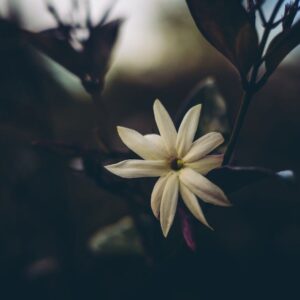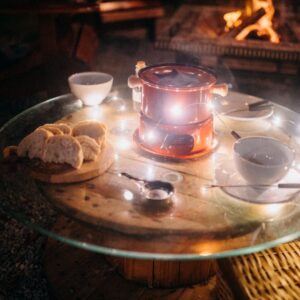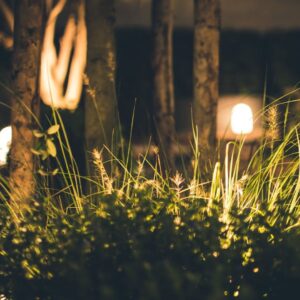While many of us love admiring our gardens in daylight, have you considered creating a garden you’d enjoy under the moonlight? Yes, while we love the bright colors of sun-filled gardens, there’s something magical about a soothing and mysterious moon garden.
In this blog post, we’ll explore what moon gardens are and dive into ideas and tips for creating and maintaining your own moon garden.
What’s a Moon Garden?
A moon garden is exactly what it sounds like: a garden to be enjoyed under the moonlight. It’s similar to any other backyard home garden, but the key factor in a moon garden is the types of plants you incorporate. Instead of the vibrance you’d expect from a garden you’d say in broad daylight, you’ll find plants that are white or light in color to better reflect the moonlight. Your nose will also be pleased by any fragrant plants you select for your moon gardening, making it a multi-sensory experience under the stars.
Does a Moon Garden Have Benefits?
While you’re taking in the end of your day, maybe enjoying a cool breeze in the air, relaxing in your moon garden has several different benefits.
1. Sit Back & Relax
It can be therapeutic for your body to relax in a quiet space after a long day. Notice the calmness in the air, and take a beat to let your body and mind settle. A moon garden can be a wonderful space to meditate, journal, and just be with your thoughts.
2. Nightime Serenades
The evening sounds of crickets chirping maybe a water feature gurgling away, are more easily enjoyed when the rest of the world around has fallen silent for bedtime.
3. For Yourself & For Others
This can be a great space for family and friends to gather and share stories of the day that has passed, or plan for the new day ahead.
How Do I Start a Moon Garden?
Ready to get started? Here are some simple steps to take to get your moon garden ready.
1. Consider Your Space
First, choose a spot where there’s good moon exposure and minimal artificial lighting that may interfere with the impact of the moonlight over your garden.
Take a look at the current layout of your landscape to help you better understand exactly how much free space you have, or if you’re able to move some things around to create the space you’d enjoy.
2. Select Your Plants
Here comes one of the most fun parts! Choose suitable plants for your moon garden so it thrives even in the shadows of the night. Think about white flowering plant varieties, silver-foliage plants, and especially night-blooming flowers. And don’t forget about texture, size, and height to help create contrast and depth.
Here are some of our top plant picks for your moon garden:
- Moonflower (Ipomoea alba)
Doesn’t the moonflower sound like it belongs in a moon garden? Enjoy the look of how these beauties really pop when it’s dark outside. These are easy to grow from seed in the spring, so look for them in March / April in the seed section.
- Dusty Miller (Jacobaea maritima)
The unique look of silver foliage is eye-catching in moon gardens. This plant grows compactly, so it would be a great choice for smaller spaces. This is an annual in Utah, and a great one to pick up in early spring to enjoy throughout the season. It does have a tendency to re-seed itself, but it is one that may need to be replanted each year.
This beautiful aromatic plant produces pretty white flowers to complement your moon garden. As they are an annual in our climate, you would want to plant these in containers which you can bring indoors during the winter months.
We love hostas, there are so many varieties in all sorts of sizes and textures. Many of them have incredible variegation on the leaves with different shades of white or cream, perfect for catching the pale light of the moon.
Hydrangea, specifically the Panicle Hydrangea, have massive heads of bright white flowers through most of the summer months, only turning to greens, pinks or reds later in the season. They offer a bountiful bevy of blossoms that would gleam through those summer nights.
This is a truly lovely perennial! The leaf texture is either furry or rough depending on the variety you find, though most are as soft as a lamb’s ear (hence the name) with tiny white fuzz that makes them stand out in the night. They are vigorous growers with beautiful purple flowers when they bloom. The plants aren’t fussy and the flowers attract pollinators!
The perfect addition to any relaxing space is lavender. These fragrant flowers are also great for drying and making oils. Plus, bumblebees love it!
Magnolias can be a great way to add a dramatic effect to our moon garden, making your landscape come to life at night. An early spring bloomer like Royal Star combined with a later season bloomer like Edith Bogue would make for a dazzling and aromatic display from early spring through mid-summer.
- Night-Blooming Jasmine (Cestrum nocturnum)
Now this is a reason to stop and smell the flowers! This intoxicating scent will have you and your guests coming back night after night. This is an annual in our area, so it is one that would need to be grown in a container and brought in for the winter months.
Pretty peonies for the win! Oh, how these decadent beauties will add to your moon garden, especially the white or pale pink varieties. Though they have a shorter bloom season, the hearty blossoms pack an incredible punch when they are in bloom.
To discover more plants fit for a moon garden, check out our full catalog here.
Looking for more easy-to-grow plants for your moon garden that are native to Utah so they thrive? Get our free guide here
Consider More Than Just Plants
Seats and Tables
To enjoy your moon garden, ensure you select comfy seating, with tables for you to set down your beverages, journals, radios, and more. Even better if you can surround a firepit with seats for cozy storytelling time.
Basket-o-Fun!
You may even want to keep a basket near the door full of items you’d use in your moon garden, like a blanket to lay down on and watch the stars, a small pillow to get comfy, or grab some of your fresh herbs that are known to keep the mosquitoes at bay.
Water, Please!
If you enjoy the sound of water babbling away, incorporating a water feature helps enhance tranquility. Did you know we sell pondless rock fountain installation kits? With our step-by-step guide, you’ll have yours installed to enjoy in no time. Learn more about custom water features at Glover Nursery here.
Pave The Way
If you have the space, add some pathways for leisurely strolls.
Sound it Out
Sound elements like wind chimes or even a sound machine can help elevate this sensory experience if you’re not in an area where you can hear crickets or nature sounds all the time.
Moon Garden Maintenance & Care
Just like any other type of garden, your maintenance and care will be important to its survival. Here are a few things to keep in mind:
Water Wisely
Consider a drip irrigation system or collecting rainwater to maintain a lush garden, while conserving water.
Night Lighting
While the moon provides natural light, you can try adding some solar-powered lighting to accentuate any pathways to help you see better in the dark. But, keep them to a minimum if the goal is to enjoy the moon. Or, maybe put them on a switch so you only use them when the moon is hiding.
Regular Maintenance
Deadhead, prune, and weed your moon garden! If you forget, you can pencil it into your calendar or set a reminder on your phone. Just because it’s dark out doesn’t mean you can’t see what your plants need! (We recommend maintenance during the daytime so you can see in the sunlight rather than a dimmer moonlight.)
Moon gardens can be as enchanting as you make them, and are a unique way to show off your creativity and the beauty of your gardening skills. Incorporate more magic into your lives and the lives of your loved ones. To continue the conversation about moon gardens, join our Facebook Group here.
Happy moon gardening!

